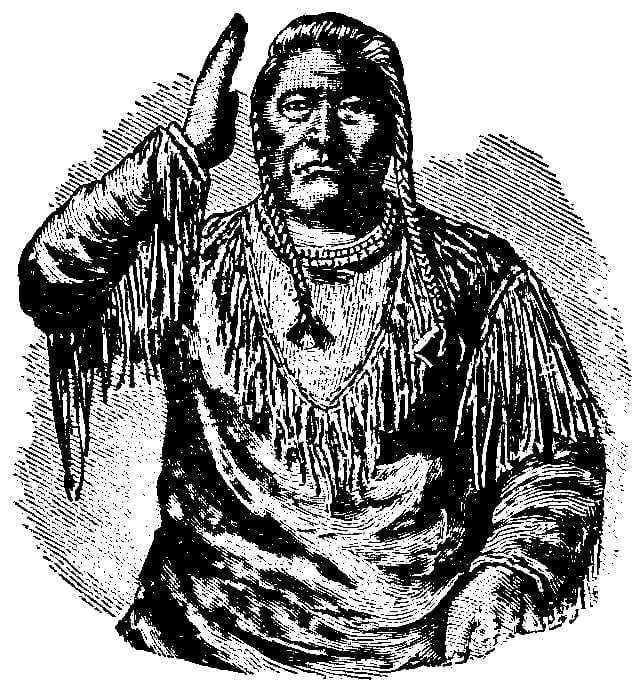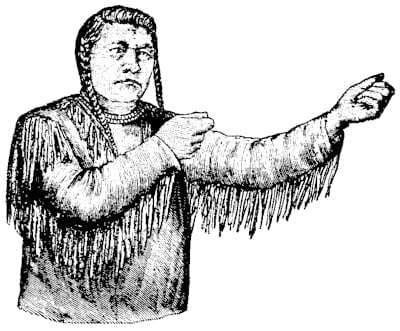Cree, Knisteno, Kristemeaux
Sign for Wagon and then the sign for Man. (Dakota I.) “This indicates the Red River half-breeds, with their carts, as these people are so known from their habit of traveling with carts.”
Place the first and second fingers of the right hand in front of the mouth. (Kutine I.)
Crow, See Absaroka
Dakota, or Sioux
The edge of the hand passed across the throat, as in the act of cutting that part. (Long; Marcy in Army Life, p. 33.)
Draw the lower edge of the hand across the throat. (Burton.)
Draw the extended right hand across the throat. (Arapaho I.) “The cut-throats.”
Pass the flat right hand, with palm down, from left to right across the throat. (Arapaho II; Cheyenne V; Dakota VI, VIII; Ponka II; Pani I.)
Draw the forefinger of the left hand from right to left across the throat. (Sac, Fox, and Kickapoo I.) “A cut-throat.”
Forefinger and thumb of right hand extended (others closed) is drawn from left to right across the throat as though cutting it. The Dakotas have been named the “cut-throats” by some of the surrounding tribes. (Dakota I.) “Cut-throats.”
Right hand horizontal, flat, palm downward (as in W), and drawn across the throat as if cutting with a knife. (Dakota II, III.)
Draw the open right hand, or the right index, from left to right horizontally across the throat, back of hand upward, fingers pointing toward the left. This sign is also made by the Arapahos. (Dakota IV.) “It is said that after a battle the Utes took many Sioux prisoners and cut their throats; hence the sign “cut-throats.”
Draw the extended right hand, palm downward, across the throat from left to right. (Kaiowa I; Comanche II, III; Shoshoni and Banak I; Ute I; Apache II; WichitaII.) “Cut-throats.” Fig 290.

Blackfoot (Sihasapa)
Pass the flat right hand along the outer edge of the foot from the heel to beyond the toes. (Dakota VIII; Hidatsa I; Ponka II; Arikara I; Pani I.) Same as Fig. 286, above.
Pass the right hand quickly over the right foot from the great toe outward, turn the heel as if brushing something therefrom. (Dakota V.)
Pass the widely separated thumb and index of the right hand over the lower leg, from just below the knee nearly down to the heel. (Kaiowa I; Comanche III; Apache II; Wichita II.)
Brulé
Rub the upper and outer part of the right thigh in a small circle with the open right hand, fingers pointing downward. This sign is also made by the Arapahos. (Dakota IV.) “These Indians were once caught in a prairie fire, many burned to death, and others badly burned about the thighs; hence the name Si-can-gu ‘burnt thigh’ and the sign. According to the Brulé chronology, this fire occurred in 1763, which they call ‘The-People-were-burned-winter.'”
Pass the flat right hand quickly over the thigh from near the buttock forward, as if brushing dust from that part. (Dakota V, VI, VII, VIII.)
Brush the palm of the right hand over the right thigh, from near the buttock toward the front of the middle third of the thigh. (Kaiowa I; Comanche III; Apache II; Wichita II.)
Ogalala
Fingers and thumb separated, straight (as in R), and dotted about over the face to represent the marks made by the small-pox. (Arapaho II; Cheyenne V; Dakota III, VI, VII, VIII.) “This band suffered from the disease many years ago.”
With the thumb over the ends of the fingers, hold the right hand upright, its back forward, about six inches in front of the face, or on one side of the nose near the face, and suddenly extend and spread all the fingers, thumb included. (Dakota IV.) “The word Ogalala means scattering or throwing at, and the name was given them, it is said, after a row in which they threw ashes into one another’s faces.”
Flathead, or Selish
One hand placed on the top of the head, and the other on the back of the head. (Long.)
Place the right hand to the top of the head. (Kutine I.)
Pat the right side of the head above and back of the ear with the flat right hand. (Shoshoni and Banak I.) From the elongation of the occiput. Fig. 291.

Fox, or Outagami
Same sign as for Sac. (Sac, Fox, and Kickapoo I.)
Gros Ventre, See Hidatsa
Hidatsa, Gros Ventre, or Minitari
Both hands flat and extended, palms toward the body, with the tips of the fingers pointing toward one another; pass from the top of the chest downward, outward, and inward toward the groin. (Absaroka I; Dakota V, VI, VII, VIII; Shoshoni and Banak I.) “Big belly.”
Left and right hands in front of breast, left placed in position first, separated about four or five inches, left hand outside of the right, horizontal, backs outward, fingers extended and pointing left and right; strike the back of the right against the palm of the left several times, and then make the sign for Go, Going, as follows: Both hands (A 1) brought to the median line of body on a level with the breast, some distance apart, then describe a series of half circles or forward arch-like movements with both hands. (Dakota I.) “The Gros Ventre Indians, Minitaris (the Hidatsa Indians of Matthews), are known to the Sioux as the Indians who went to the mountains to kill their enemies; hence the sign.”
Express with the hand the sign of a big belly. (Dakota III.)
Pass the flat right hand, back forward, from the top of the breast, downward, outward, and inward to the pubis. (Dakota VI; Hidatsa I; Arikara I.) “Big belly.”
Indian (generically)
Hand in type-position K, inverted, back forward, is raised above the head with forefinger directed perpendicularly to the crown. Describe with it a short gentle curve upward and backward in such a manner that the finger will point upward and backward, back outward, at the termination of the motion. (Ojibwa V.) “Indicates a feather planted upon the headthe characteristic adornment of the Indian.”
Make the sign for White Man, viz: Draw the open right hand horizontally from left to right across the forehead a little above the eyebrows, the back of the hand to be upward and the fingers pointing toward the left, or close all the fingers except the index, and draw it across the forehead in the same manner; then make the sign for NO; then move the upright index about a foot from side to side, in front of right shoulder, at the same time rotating the hand a little. (Dakota IV.)
Rub the back of the extended left hand with the palmar surfaces of the extended fingers of the right. (Comanche II.) “People of the same kind; dark-skinned.”
Rub the back of the left hand with the index of the right. (Pai-Ute I; Wichita I.)
Kiowa
Make the signs of the Prairie and of Drinking Water. (Burton; Blackmore in Dodge’s Plains of the Great West. New York, 1877, p. xxiv.)
Cheyennes make the same sign as (Comanche II), and think it was intended to convey the idea of cropping the hair. The men wear one side of the hair of the head full length and done up as among the Cheyennes, the other side being kept cropped off about even with the neck and hanging loose. (Cheyenne II.)
Right-hand fingers and thumb, extended and joined (as in W), placed in front of right shoulder, and revolving loosely at the wrist. (Dakota III.)
Place the flat hand with extended and separated fingers before the face, pointing forward and upward, the wrist near the chin; pass it upward and forward several times. (Kaiowa I; Comanche III; Apache II; WichitaII.)
Place the right hand a short distance above the right side of the head, fingers and thumb separated and extended; shake it rapidly from side to side, giving it a slight rotary motion in doing so. (Comanche II.) “Rattle-brained.” Fig. 292. See p. 345 for remarks upon this sign.

Same sign as (Comanche II), with the exception that both hands are generally used instead of the right one only. (Ute I.)
Make a rotary motion of the right hand, palm extended upward and outward by the side of the head. (Wichita I.) “Crazy heads.”
Kickapoo
With the thumb and finger go through the motion of clipping the hair over the ear; then with the hand make a sign that the borders of the leggings are wide. (Sac, Fox, and, Kickapoo I.)
Knisteno or Kristeneaux, See Cree
Kutine
Place the index or second finger of the right hand on each side of the left index finger to imitate riding a horse. (Kutine I.)
Hold the left fist, palm upward, at arm’s length before the body, the right as if grasping the bowstring and drawn back. (Shoshoni and Banak I.) “From their peculiar manner of holding the long bow horizontally in shooting.” Fig. 293.

